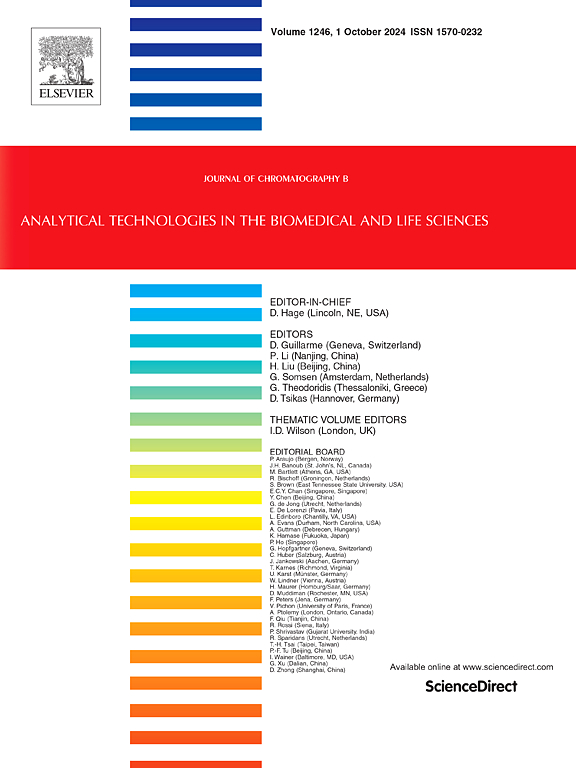稳定性指示反相高效液相色谱法定量利伐沙班(XARELTO)的建立与验证
IF 2.8
3区 医学
Q2 BIOCHEMICAL RESEARCH METHODS
引用次数: 0
摘要
利伐沙班是一种抗凝药物,针对血液凝固过程中的关键阶段,防止血栓的形成和生长。它通常用于防止血栓形成或抑制现有血栓的扩大。利伐沙班作为Xa因子抑制剂,用于:降低非瓣膜性房颤患者卒中和全身性栓塞的风险,治疗深静脉血栓形成(DVT)和肺栓塞(PE),以及降低DVT和PE复发的风险,预防可能导致膝关节或髋关节置换术患者发生PE的DVT。建立了一种可靠、精确、选择性高的反相高效液相色谱(HPLC)方法,用于分析原料中的利伐沙班。采用Thermo ODS Hypersil C18色谱柱(4.6 × 250 mm, 5 μm),室温等压洗脱,流速为1ml /min。流动相为磷酸一碱钾,pH为2.9,乙腈为70:30 (v/v)比,紫外检测波长为249 nm。在50 ~ 1000 ppm的浓度范围内呈线性关系(r2 = 0.999),利伐沙班的保留时间约为12 min,精密度和准确度的相对标准偏差(RSD)均小于2.0%。利伐沙班在酸碱水解、过氧化氢氧化、加热和紫外线照射等条件下进行了强制降解。该方法的特异性、稳健性、线性、准确性、精密度、检出限(LOD)和定量限(LOQ)均按照国际协调会议(ICH)的指导方针进行了验证。杂质和降解物的LOD为0.3 ppm, LOQ为1 ppm。本文章由计算机程序翻译,如有差异,请以英文原文为准。
Development and validation of a stability-indicating reversed phase high-performance liquid chromatography method for quantifying rivaroxaban (XARELTO)
Rivaroxaban is an anticoagulant medication that targets a key stage in the blood clotting process, preventing the formation and growth of clots. It is commonly used to prevent thrombosis or inhibit the enlargement of existing clots. Rivaroxaban functions as a Factor Xa inhibitor and is indicated for: reducing the risk of stroke and systemic embolism in patients with non-valvular atrial fibrillation, treating deep vein thrombosis (DVT) and pulmonary embolism (PE), as well as reducing the risk of recurrent DVT and PE, and prophylaxis of DVT, which may lead to PE in patients undergoing knee or hip replacement surgery.
A robust, precise, and selective reversed-phase high-performance liquid chromatography (HPLC) method was developed and validated for analyzing Rivaroxaban in raw materials. Isocratic elution at a flow rate of 1 mL/min was performed using a Thermo ODS Hypersil C18 column (4.6 × 250 mm, 5 μm) at ambient temperature. The mobile phase consisted of monobasic potassium phosphate at pH 2.9 and acetonitrile in a 70:30 (v/v) ratio, with UV detection at 249 nm. Linearity was established in the concentration range of 50–1000 ppm (r2 = 0.999), and the retention time for Rivaroxaban was approximately 12 min. The percentage relative standard deviation (RSD) for precision and accuracy was consistently below 2.0 %. Rivaroxaban was subjected to forced degradation under various conditions, including acid and base hydrolysis, hydrogen peroxide oxidation, heat, and UV light exposure. The developed method was validated for specificity, robustness, linearity, accuracy, precision, limit of detection (LOD), and limit of quantitation (LOQ), following International Conference on Harmonisation (ICH) guidelines. The LOD for impurities and degradants was found to be 0.3 ppm, with an LOQ of 1 ppm.
求助全文
通过发布文献求助,成功后即可免费获取论文全文。
去求助
来源期刊

Journal of Chromatography B
医学-分析化学
CiteScore
5.60
自引率
3.30%
发文量
306
审稿时长
44 days
期刊介绍:
The Journal of Chromatography B publishes papers on developments in separation science relevant to biology and biomedical research including both fundamental advances and applications. Analytical techniques which may be considered include the various facets of chromatography, electrophoresis and related methods, affinity and immunoaffinity-based methodologies, hyphenated and other multi-dimensional techniques, and microanalytical approaches. The journal also considers articles reporting developments in sample preparation, detection techniques including mass spectrometry, and data handling and analysis.
Developments related to preparative separations for the isolation and purification of components of biological systems may be published, including chromatographic and electrophoretic methods, affinity separations, field flow fractionation and other preparative approaches.
Applications to the analysis of biological systems and samples will be considered when the analytical science contains a significant element of novelty, e.g. a new approach to the separation of a compound, novel combination of analytical techniques, or significantly improved analytical performance.
 求助内容:
求助内容: 应助结果提醒方式:
应助结果提醒方式:


